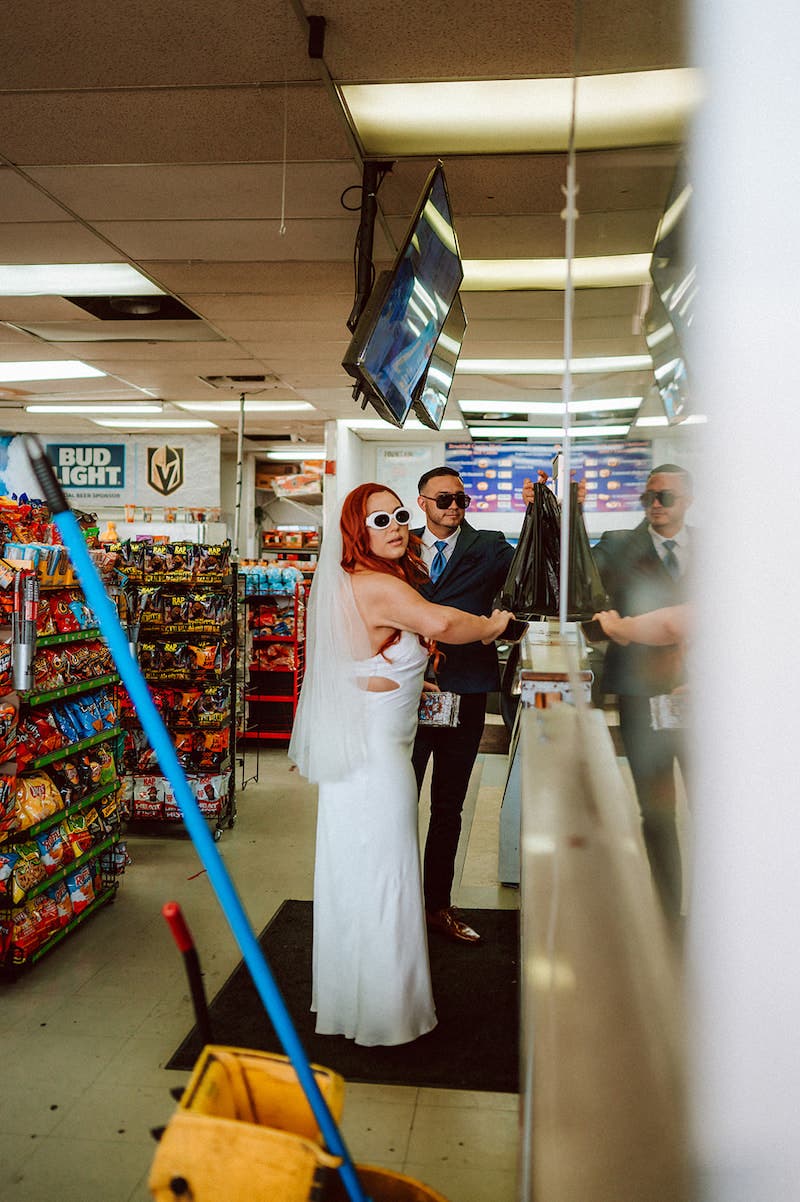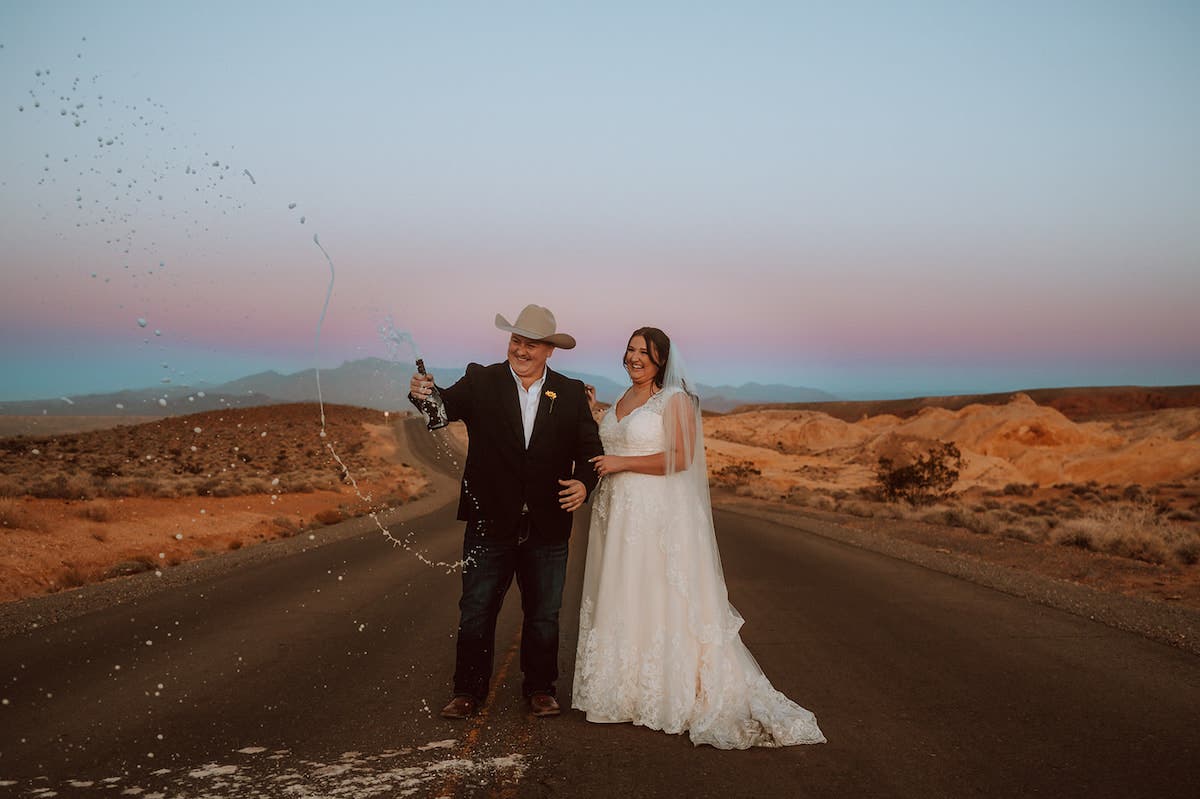As a first-generation Mexican-American, wedding and elopement photographer, and mental health therapist in my hometown of Las Vegas, Nevada, I usually say that I’m one of the lucky ones when people ask what I do for a living. I get to be a part of the most wonderful moments in the lives of many people. Here in Las Vegas, elopement photography is what I shoot the most.
As you can imagine, I photograph couples from all over the world. Being bilingual certainly helps me communicate with couples, but I also rely on body language to help me understand how to differentiate poses for every couple.
Before I meet my couples, I ask for Instagram handles to gather some information about their personality. I can usually tell whether the couple has a quirky sense of humor through their captions, hilarious memes, the Halloween costumes they chose a few months ago, and their candidness. Being able to work with different personalities is gold for me, and it allows me to gauge the next scene or idea.

Angles and Poses That Work Best
Adapt to Their Mood
The best angles and poses will depend on your couple. Think of them as movie characters and direct their sweet interactions while keeping their personality and interests in mind. This is the perfect opportunity to capture subtle moments. The same goes for when I get a couple who might be jet-lagged, hungry, hungover, or tired. I observe their behavior and become a support system before their exhaustion interferes with their mood. In this case, I might suggest that we stop at a convenience store to pick up a drink or a snack and — boom! — there is a photoshoot right there. I stand on one side of the store aisles and document their selections as well as their giggles.

Catch the Small Moments
I always begin my sessions as an elopement photographer by letting that couple know that they can slow it down. Whether they are exchanging rings or popping champagne on a mountain after the vows, I advise them to take their time and make their touches flow. Posing is intimidating for everyone involved. Although, I tell myself that I have all that I need in front of me — even when I forget the inspiration poses I had made sure to memorize beforehand.
Throughout the shoot, I look for the touches, flirty smiles, the way she tucks his hair back, the details in their wardrobe, and the little moments that make them smile. For example, if I ask one of them to place their arms around their partner, I also encourage them to keep going. Dance a little, sway, take each other’s hands, or reach for the sky. I’m also not afraid to be silly myself. If I’m confident and playful, they are going to feed off my energy too.
When it comes to directing the couple, I tell my clients that I will work off their energy and their chemistry. This is the truth. Sure, we can start off with your normal side-by-side poses that usually get sent to grandma. But my true focus is the spunky attitude and the way they tease one another.

Remind Them to Be Mindful
In short, I believe that it’s important to get those traditional poses in various locations. But an elopement photographer should try to deliver a fun and authentic experience. The entire day is full of stomach butterflies, but I’m here to remind them to be mindful. You’ll never be in Vegas right after having married your partner ever again. Twirl, dance, feed each other pizza, skip down Fremont Street — I’m here for it.
For example, we can be walking to the next location and the groom might walk ahead out of anxiety. I’ll often tell his partner, “Run up and pull him in for a kiss.” This usually surprises him and, all of a sudden, we have smiles and motion in a photo!
Best Locations for Elopement Photography
You’ll definitely get lucky in Vegas when looking for iconic locations. Aside from The Strip, Downtown, and the Arts District, you can rent a car and travel around 40 minutes (one way) to the various locations such as Red Rock, Valley of Fire, Seven Magic Mountains, or Mt. Charleston. We even have a sand dune and a couple of dry lake beds that are incredibly beautiful during sunset.

Choosing a wedding photography location that works for your couple should be based on who the couple is. With proper permits, the photographer and officiant can meet you anywhere. It is not uncommon that a couple will want to get married at a chapel in the city and then travel to the desert for images among Joshua Trees and an amber sunset. I usually send my clients an itinerary with coordinates to make sure we are on the same page. If I’m able to, I check out the location ahead of time in case there needs to be a change of plans. If one location does not work, I always keep two others nearby in the back of my mind.
Best Gear for Elopement Photography
While I’m telling all of my secrets, I should mention my go-to gear picks. In 1995, I got my first camera — a Nikon L35AF. Since then, I’ve only shot Nikon. I bring three bodies with me to every elopement: Two Nikon 6ii and one film camera for those dreamy, nostalgic shots.
On one Nikon 6ii body, I shoot with a Nikon Z 50mm f/1.2 lens. My Nikon Z 50mm f/1.2 lens is by far the most beautiful lens I’ve shot with. Yes, it’s a bit heavy, but I appreciate the glass quality and detail in every shot. During daytime sessions, I often like to shoot at a f/2.8 because I like to photograph my couples candidly.
On my film camera, you will find a Nikon 35mm f/1.8 lens. I also bring a Nikon Z 85mm f/1.8 as a backup or if the setting calls for it. I love to use my 85mm f/1.8 in the desert standing on one hill while my subjects are on another.
When I can’t set an AD200 flash on a stand, or have an assistant hold it up with an Adorama diffuser attached, I place my Godox V860ii in my hot shoe with a Magmod Magsphere diffuser.
Best Camera Settings for Elopement Photography
If needed, I’m not afraid to turn up my ISO. I would rather get a grainy image than an out-of-focus one. Shooting on Cloudy White Balance is also helpful for me and my style of editing. I rarely switch this.
For night time shots, my settings usually stay at 125 shutter speed, 2000 ISO, with a 1.8/f lens. My on-camera flash is usually at a low-power setting of 1/128. Although, I prefer shooting Manual because I’m a person that thrives on control of my camera.
I often shoot on Aperture Priority, especially if we are moving through the streets and may encounter neon lights, moving tourists, colorful murals, or a sun that is ready to set. I may sound dramatic, but this can happen in a flash in this town. If I plan to stay in a location with constant lighting, I will switch to Manual mode to make the image my own.

Tips from an Elopement Photographer
Get to Know the Couple
Being an elopement photographer is incredibly fun, but it also comes with some responsibility. Get to know your couple. What do they envision for their wedding day? This is a day they will remember forever. Never forget that having been chosen as their photographer is an honor — they chose you! Work with their strengths and thrive off their vibe.
Look into Permit Requirements
Find out if you need permits to photograph at all the locations. Scout the locations ahead of time, and provide tips on what to wear depending on the weather and terrain. Know your town and walk around the area where you might be shooting. Notice where the sun will go down, plan for the weather, and communicate with your couple before their wedding day.

Be Prepared to Go with the Flow
If they are rushing to get their marriage license right before the ceremony and you seem annoyed, they are going to remember that. Remind them that you are there to document their story and all of its memorable events. Be excited with them, hype them up, and remind them that the day is their day.
Final Thoughts
You don’t need the most expensive gear to be an elopement photographer, but you do need to know your gear. Think of how much space you’ll have to shoot when choosing a lens and never leave the house without your flash. When you feel comfortable and you know that you’ve acquired some great shots, bring out the fun filters to create dreamy surroundings. You never know — you might discover a lot about who you are as an artist and, more importantly, what sets you apart from other professionals in your area.






